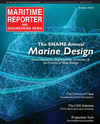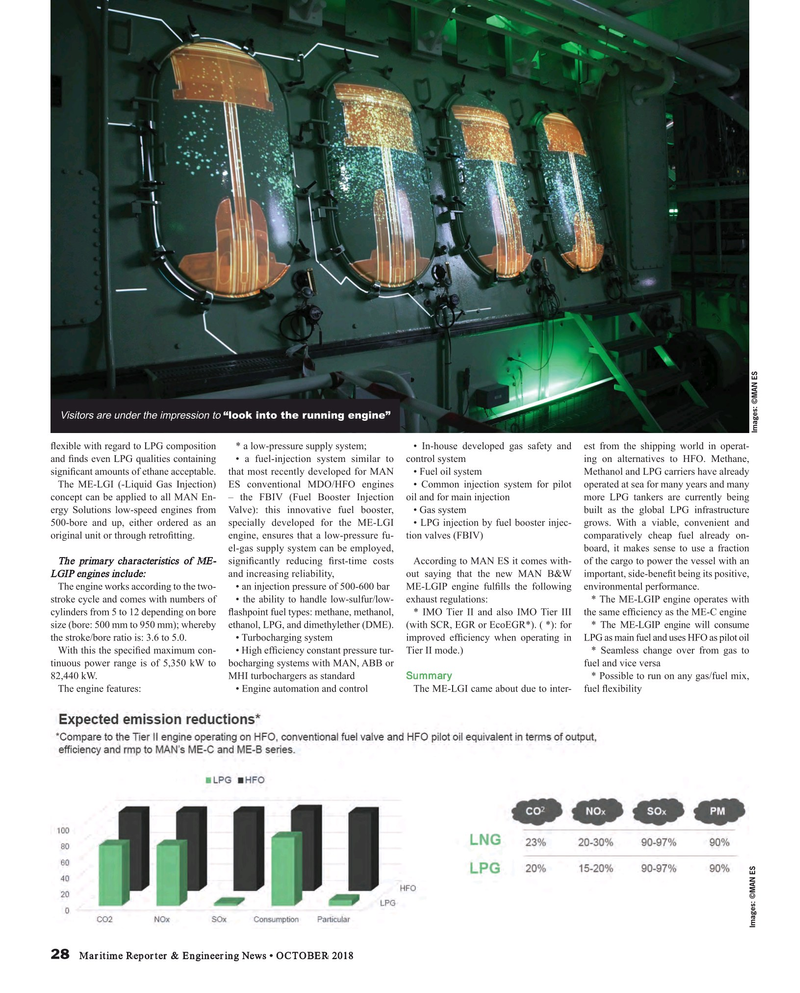
Page 28: of Maritime Reporter Magazine (October 2018)
Marine Design Annual
Read this page in Pdf, Flash or Html5 edition of October 2018 Maritime Reporter Magazine
Visitors are under the impression to “look into the running engine”
Images: ©MAN ES ? exible with regard to LPG composition * a low-pressure supply system; • In-house developed gas safety and est from the shipping world in operat- and ? nds even LPG qualities containing • a fuel-injection system similar to control system ing on alternatives to HFO. Methane, signi? cant amounts of ethane acceptable. that most recently developed for MAN • Fuel oil system Methanol and LPG carriers have already
The ME-LGI (-Liquid Gas Injection) ES conventional MDO/HFO engines • Common injection system for pilot operated at sea for many years and many concept can be applied to all MAN En- – the FBIV (Fuel Booster Injection oil and for main injection more LPG tankers are currently being ergy Solutions low-speed engines from Valve): this innovative fuel booster, • Gas system built as the global LPG infrastructure 500-bore and up, either ordered as an specially developed for the ME-LGI • LPG injection by fuel booster injec- grows. With a viable, convenient and original unit or through retro? tting. engine, ensures that a low-pressure fu- tion valves (FBIV) comparatively cheap fuel already on- el-gas supply system can be employed, board, it makes sense to use a fraction
The primary characteristics of ME- signi? cantly reducing ? rst-time costs According to MAN ES it comes with- of the cargo to power the vessel with an
LGIP engines include: and increasing reliability, out saying that the new MAN B&W important, side-bene? t being its positive,
The engine works according to the two- • an injection pressure of 500-600 bar ME-LGIP engine ful? lls the following environmental performance. stroke cycle and comes with numbers of • the ability to handle low-sulfur/low- exhaust regulations: * The ME-LGIP engine operates with cylinders from 5 to 12 depending on bore ? ashpoint fuel types: methane, methanol, * IMO Tier II and also IMO Tier III the same ef? ciency as the ME-C engine size (bore: 500 mm to 950 mm); whereby ethanol, LPG, and dimethylether (DME). (with SCR, EGR or EcoEGR*). ( *): for * The ME-LGIP engine will consume the stroke/bore ratio is: 3.6 to 5.0. • Turbocharging system improved ef? ciency when operating in LPG as main fuel and uses HFO as pilot oil
With this the speci? ed maximum con- • High ef? ciency constant pressure tur- Tier II mode.) * Seamless change over from gas to tinuous power range is of 5,350 kW to bocharging systems with MAN, ABB or fuel and vice versa 82,440 kW. MHI turbochargers as standard Summary * Possible to run on any gas/fuel mix,
The engine features: • Engine automation and control The ME-LGI came about due to inter- fuel ? exibility
Images: ©MAN ES 28 Maritime Reporter & Engineering News • OCTOBER 2018
MR #10 (26-33).indd 28 MR #10 (26-33).indd 28 10/4/2018 10:02:03 AM10/4/2018 10:02:03 AM

 27
27

 29
29
